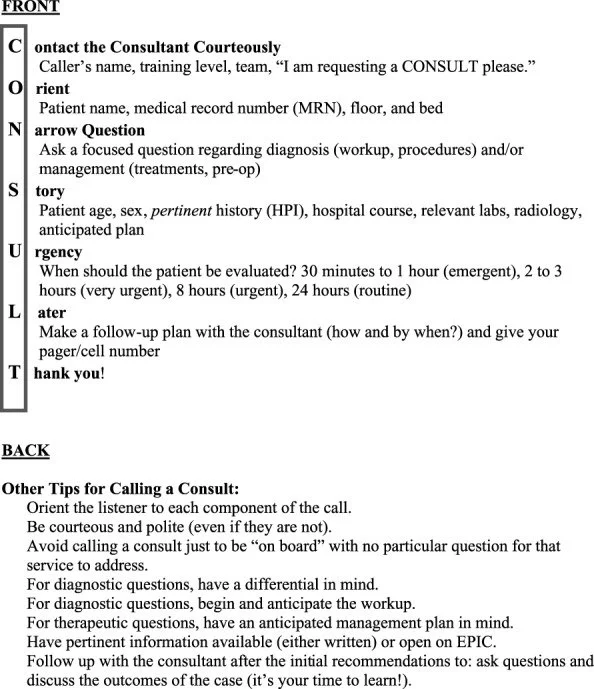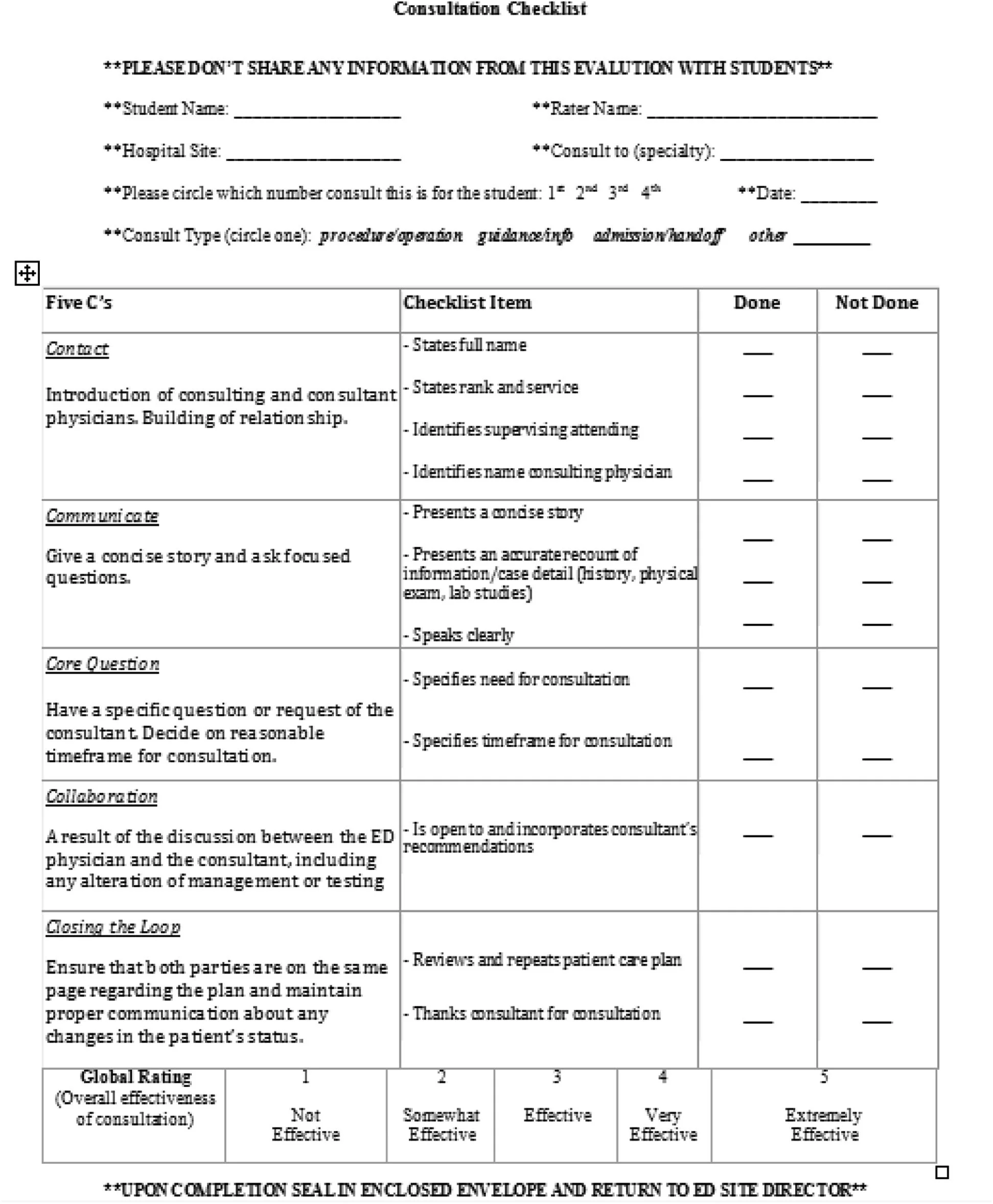How to Request a Consult
Whether you are working in the hospital or clinic, you will likely need to request a consult from another specialty or service at some point during your training.
Knowing how to do this effectively is a crucial skill that will not only help you provide the best possible care for your patients, but also demonstrate your professionalism and communication skills to your colleagues.
Here we’ll cover:
What is a consult request?
Components of a Consult Request
Tips for an Effective Consult Request
Examples of Consult Requests
I. What is a Consult Request?
Requesting a consult refers to the process of asking for advice or assistance from another medical specialty or service regarding the care of a patient. This can be done in a variety of ways, but often involves a phone call or electronic communication to the consulting service.
When to Request a Consult
There are several reasons why you might need to request a consult. For example, you may need a specialist's input on a complex medical issue, guidance on management of a particular condition, or assistance with a procedure.
Regardless of the reason, it is important to be clear and concise when making the request to ensure that the consulting service understands what you need and can provide appropriate assistance.
As a clinical clerk, you will likely be involved in many consult requests throughout your training, so it's important to approach each request with confidence and professionalism.
II. Components of a Consult Request
When requesting a consult, there are several key components that should be included to ensure that the consulting service understands your request and can provide appropriate assistance.
Consult requests should not be long-winded. They should be a brief introduction, your question/reason for the consult, pertinent patient information (usually a few sentences), and urgency of the request. The consultant will ask any relevant follow up questions.
These components include:
Introduction: Confirm you are speaking to the corrective service, thank thank them for calling you back. Introduce who you are (name, designation and service). Be polite and appreciative.
"Hello, this is [Your Name], a clinical clerk on the [Service Name] team. I'm calling to request a consult from [Consulting Service Name].”
Provide the patient’s information: Briefly indicate the patient’s name and the medical record number (MRN) so that the consultant can look up the patient chart electronically while you share the story.
“Can I give you the patient’s name and MRN? Great! Patient’s name is [Name], MRN is [hospital number] located on [Unit Name, Bed Number].”
Start with the Reason for the Request: Include your question here, which provides context
We're concerned that the patient may have [Potential Diagnosis] and we would appreciate your input on how to proceed.
Discuss the patient’s story: Here you will include a brief summary of the patient’s story. Provide any relevant clinical information that may be helpful for the consulting service to know, such as the patient's medical history, recent lab results, or imaging studies.
“Patient is a [age] [gender] admitted for [diagnosis], but has recently developed [insert relevant details about the medical condition including history, labs, interventions thus far, etc.]
Urgency of the request: Depending on the nature of the consult, it may be important to convey the urgency of the request.
“The patient is stable at present, but if you could see them at some point today“
Conclude: Thank the consultant for their time, inquire about any tests or orders you can input or start, and provide your contact information in case (your name and pager number). At this point the consultant may ask additional questions or request you input some initial orders or tests in before they come to see the patient.
“Thank you in advance for seeing this patient! Just in case my name is [name] and my pager number is [number]. Are there any initial tests or orders you’d like me to put in in the meantime? Thanks again!”
By including these key components in your consult request, you can ensure that the consulting service understands your needs and can provide appropriate assistance in a timely manner.
III. Tips for an Effective Consult Request
Before you make the consult request, review the patient’s chart
Familiarize yourself with the patient's history and relevant information before calling a specialist, as this can help the consultant gain a better understanding of the patient's condition. THis may require a chart review, and organizing your thoughts before placing the call.
This will include having the patient’s story, and any relevant ancillary information prepared (exam findings, labs, interventions, current meds, etc.).
Understand why the Consult is being requested
Before calling the consultant, you should consider the urgency of the consult and why it is necessary.
It is important to avoid calling a consult just because someone told you to; instead, take the time to assess the patient's needs and discuss the need for the consult.
If you are uncertain as to why the consult is required, be sure to discuss with with the attending staff or resident beforehand.
Be clear and concise
When making a consult request, it is important to be clear and concise with your message. State the reason for the consult, provide relevant patient information, and specify the urgency of the request.
Be polite and professional
Always be polite and professional when making a consult request. Remember that you are representing your team and the hospital, and your behavior reflects on them. Building good rapport will make it easier to request consults in the future from that service
Listen actively
Listen carefully to any questions or concerns raised by the consulting service. This will help you understand their thought process and provide any additional information they may need.
Follow up
After making a consult request, be sure to followup afterwards by reviewing the patient chart and looking for the consultant’s notes which provides information and guidance on next steps to take. The consultant may choose to continue following the patient, or provide recommendations and sign off.
IV. Examples of Consult Request
Consult requests can vary depending on the clinical scenario and the consulting service being requested. Here are some examples of requesting a consult in different clinical scenarios:
Requesting a Consult from an Orthopaedic Surgery Service
"Hello, this is [Your Name], a clinical clerk on the General Surgery team. I'm calling to request a consult from the Orthopaedic Surgery service. Can I give you the patient’s name and MRN? Great! Patient’s name is [name], MRN is [hospital number] located on [unit name, bed number].
We’re concerned the patient may have septic arthritis of the right knee.
Patient is a 54 year old female with a history of IV drug use, and poorly controlled Diabetes currently admitted for Appendicitis. The patient has been complaining of atraumatic severe joint pain and swelling in the right knee, and has a fever of 101°F otherwise all other vital signs are stable. CT shows fluid collectin of the joint, ESR and CRP are elevated. We would like to request an urgent consult and would be grateful if you could see the patient as soon as possible.
Thank you in advance. Just in case my name is [name] and my pager number is [pager number]. Are there any initial tests or orders you’d like me to input in the meantime. Thanks again!”
Requesting a Consult from Internal Medicine
"Hello, this is [Your Name], a clinical clerk on the Neurosurgery Service. I'm calling to request a consult from the Internal Medicine service. Can I give you the patient’s name and MRN? Great! Patient’s name is [name], MRN is [hospital number] located on [unit name, bed number].
We are concerned about a patient who has developed new-onset Atrial Fibrillation.
The patient is a 68 year old male has a history of hypertension and has presented with new onset Atrial Fibrillation. We would like your input on how to manage the patient's anticoagulation therapy. All vital signs are stable, and patient appears asymptomatic. CXR demonstrates no pulonary edema. We would like to request a non-urgent consult and would appreciate your advice on the next steps.
Thank you in advance. Just in case my name is [name] and my pager number is [pager number]. Are there any initial tests or orders you’d like me to input in the meantime. Thanks again!”
Requesting a Consult from Urology when in the Emergency Department
"Hello, this is [Your Name], a clinical clerk on the Emergency Medicine team. I'm calling to request an urgent consult from the Urology service. Can I give you the patient’s name and MRN? Great! Patient’s name is [name], MRN is [hospital number] located on [unit name, bed number].
We are concerned about a patient who may have testicular torsion.
Patient is an otherwise healthy 18 year old male with a history of unilateral scrotal pain and welling. There is associated numbnes and tingling, some abdominal pain and fever. Scrotal ultrasound shows reduced blood flow to the affected testicle.
We would like to request an urgent consult and would be grateful if you could see the patient as soon as possible.
Thank you in advance. Just in case my name is [name] and my pager number is [pager number]. Are there any initial tests or orders you’d like me to input in the meantime. Thanks again!”
V. More Resources
Here are some other resources/mnemonics to help guide you!
CONSULT Card for Consults
Podolsky, A., Stern, D. T., & Peccoralo, L. (2015). The Courteous Consult: A CONSULT Card and Training to Improve Resident Consults. Journal of graduate medical education, 7(1), 113–117.
The 5C’s of Requesting a Consult
Kessler, C. S., Tadisina, K. K., Saks, M., Franzen, D., Woods, R., Banh, K. V., Bounds, R., Smith, M., Deiorio, N., & Schwartz, A. (2015). The 5Cs of Consultation: Training Medical Students to Communicate Effectively in the Emergency Department. The Journal of emergency medicine, 49(5), 713–721.
Final notes
Requesting a consult is an important part of medical practice, and clinical clerks must master this skill to ensure effective communication between healthcare providers.
By following the components of an effective consult request, using a sample "script," and keeping in mind the tips for effective communication, you an make clear and concise consult requests that result in improved patient care!


